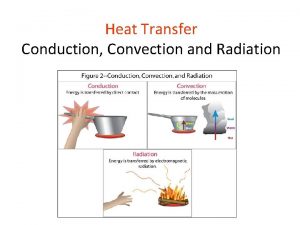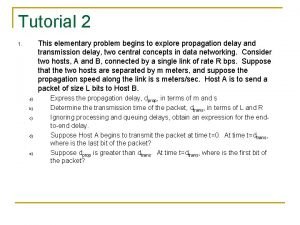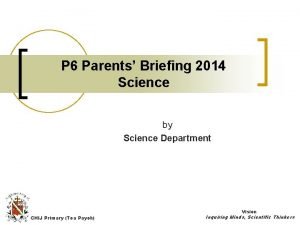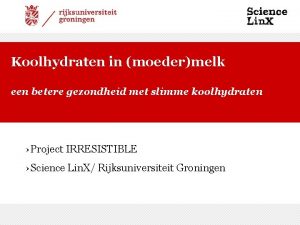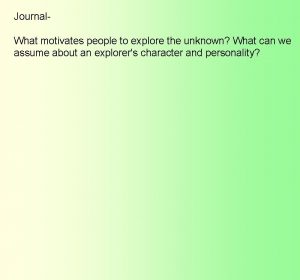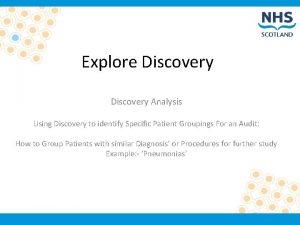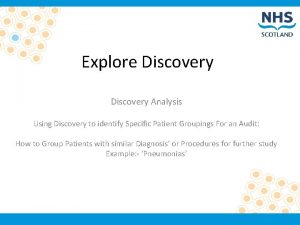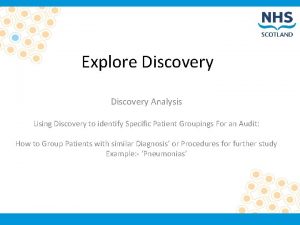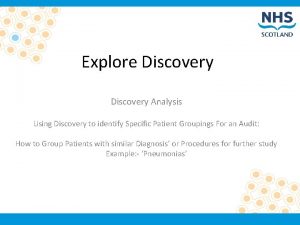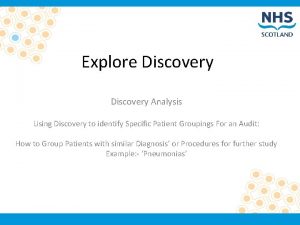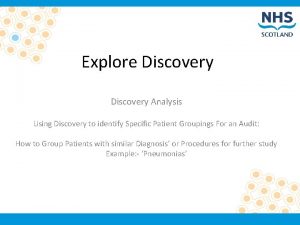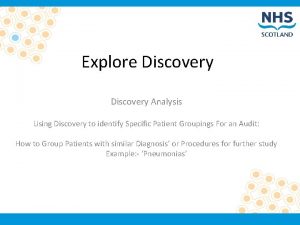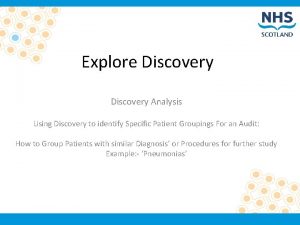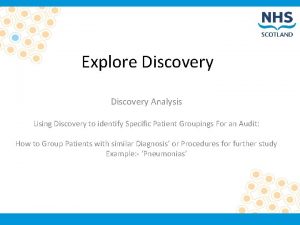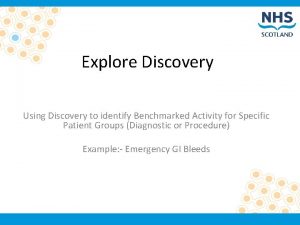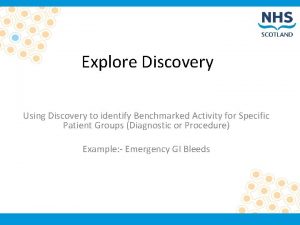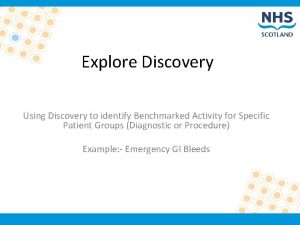Explore Discovery Analysis Using Discovery to identify Specific













- Slides: 13

Explore Discovery Analysis Using Discovery to identify Specific Patient Groupings For an Audit: How to Group Patients with similar Diagnosis’ or Procedures for further study Example: - ‘Pneumonias’

Methodology • Requested a list of Diagnosis codes that would be used for ‘Pneumonias’ from the Health Board Coding department – ICD 10 codes are the Diagnosis codes that are recorded for patient discharges from hospital • ‘Pneumonias’ ICD 10 Diagnosis Codes were identified as J 12, J 13, J 14, J 15, J 16, J 17, J 18 and P 23 • Went to: - – Discovery Landing Page, navigated to – Average LOS Spells Dashboard: Data Tables tab (Discovery Level 3) • At this Level Patient Chi information is available if user wants to pull case notes for further analysis • Click for Direct Link to Level 3 Average LOS Spells Other potential Useful Dashboards – Discovery ‘Consultant Team Dashboard’ and Procedure Diagnosis Search tab (Discovery Level 2)

Consultant Team Dashboard (Discovery Level 2): -Discovery Landing Page Click for Link to Discovery Website 1. Log into Discovery 2. Taken to Discovery Landing Page 3. Clicked on ‘Home’ Hyperlink button 4. Note Landing page also shows latest Discovery Developments and forthcoming content with hyperlinks to these areas in Discovery.

Discovery Home Page/Project Thumbnails 1. The Home button takes the user to the project page and the thumbnails show what projects the user has access to. 2. If User has level 3 access the screen will look like the one shown 3. In this Scenario click on ‘Level 3 Acute Admissions –Patient Identifiable Information 4. Note Search boxes search for key words in project titles, or workbook titles or view titles depending on what area you are searching.

Discovery Level 3 Acute Admissions Patient Identifiable Dashboards 1. There are different dashboards available depending on what patient identifiable information the user requires. 2. In this scenario the user can click on Average Length of Stay Spells

Discovery Level 3 Average Length of Stay Spells: - Data Tables 1. User should click on the Data Table Dashboard 2. This then allows the user to drill down to the actual patients that they are interested in for a specific scenario. 3. Once choices have been made in the data table a hyperlink will take you to the actual Patient data for the selections that have been made in the data table

Level 3 Average LOS Spells Treatment: -Data Tables tab Click to Link to Level 3 Average LOS Spells 1. User makes choices for HB, Location, Specialty, Admission Type here. Note if a specialty is selected only activity for this specialty will be shown. 2. User can click on Pause button while they make their choices (‘Pause’ will change to ‘resume’)and then resume button once drop down choices have been made. This means dashboard only needs to update once 3. Dashboard Updates: - User then clicks on Diagnosis Radio button (for this scenario) to choose specific Diagnosis.

Level 3 Average LOS Spells Treatment: -Data Tables tab 1. Clicking on the Diagnosis Button updates the dashboard to allow user to search for specific diagnosis. 2. User Then clicks on the ‘Restrict Table Categories’ 3. A table then appears which allows the user to focus on specific Discharge Diagnosis for this ‘specialty spell’ of treatment. 4. When you have made you diagnosis choices click on the apply button and Dashboard will update

Level 3 Average LOS Spells Treatment: -Data Tables tab 1. In this scenario the pneumonia diagnosis were searched for. Note only diagnosis codes that have been used by the HB for the selections made appear in the ‘restrict table categories’ drop down 2. Possible to amalgamate table up or down using +/buttons which become active when cursor hovers over them 3. User then clicks on a blue hyperlink number and will be taken to the patient details for this selection

Level 3 Average LOS Spells Treatment: -Patient Data 1. After clicking the blue hyperlink number you will be taken to the filtered patient date table where a list of patient information is provided 2. To Export this information to excel, click on the table to make this panel active. Make sure no individual patient is highlighted. 3. Then click on the download button, then choose the Crosstab option, (Data option is good for downloading info behind graphs). Follow the instructions that appear: Which will ask you: “The crosstab has been generated: - Cancel or Download”, click on download, then “Do you want to open or save patient_crosstab. csv from viz. nhsnss. scot. nhs. uk” click open. An excel document with the patient details will open.

Summary Information • Diagnosis and consultant information from last episode in specialty spell, Dates are based on discharge dates from the last episode of that specialty spell. A change in hospital creates a new specialty spell. Type of admission from 1 st episode in spell • Specialty Spells have been calculated as an unbroken period of time that a patient spends within a specialty. A patient may change consultant or significant facility during a specialty spell. A change in hospital location would create a new spell. • Data from Discovery can be extracted into excel format if required. • Discovery can help benchmark activity and identify unwarranted variation. • User can follow this methodology to search for patients that had specific procedures or HRGs also.

Discovery Hints and Tips • The A to Z page : highlights all the information available in Discovery and provides • • • specific links to this information. Tool Tips: Throughout Discovery if the user hovers their cursor over any of the charts or data points a tool tip will appear with additional information Custom Views: Within each dashboard area it is possible to save specific visualisations (Custom Views) incorporating any filter selections the user has made. Pause button: - Clicking on the ‘Pause’ button allows users to make all of their filter selections at once rather than one at a time. Dynamic visualisations: Many of the dashboards in NSS Discovery are dynamic. This means that if you click on one area of a chart/table it will update the other areas/panels to reflect this choice. Exporting data from Discovery: To export data, select the chart or table containing the information you wish to export (by clicking on it), then click on the button (normally located near the top right of the dashboard) and choose the format you wish the data to be exported in. Metadata: - detailed metadata is available via the head icon at the top right of all dashboards.

For Discovery support and more information on accessing and using NSS Discovery, email us at: nss. discovery@nhs. net or visit our website: www. nssdiscovery. scot. nhs. uk
 What is the specific gravity of gelato glycerin base
What is the specific gravity of gelato glycerin base Glass plummet
Glass plummet 5 examples that involve heat transfer through radiation
5 examples that involve heat transfer through radiation Explore evolve validate prototype
Explore evolve validate prototype This elementary problem begins to explore
This elementary problem begins to explore Kangaroo feet
Kangaroo feet Www.careeronestop.org/explore careers
Www.careeronestop.org/explore careers Msmoet
Msmoet Explorefood.foodafactoflife.org.uk
Explorefood.foodafactoflife.org.uk Engage explore explain elaborate evaluate
Engage explore explain elaborate evaluate Engage explore explain elaborate evaluate
Engage explore explain elaborate evaluate Examples of exploring the unknown in literature
Examples of exploring the unknown in literature How much money
How much money Explore the alternatives in decision making
Explore the alternatives in decision making


